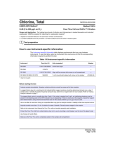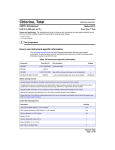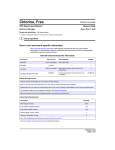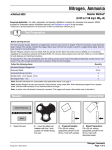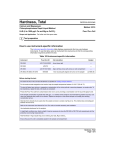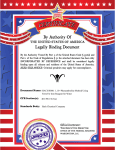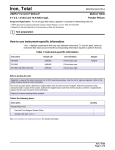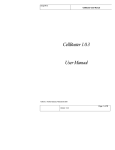Download Chlorine, Total
Transcript
Chlorine, Total (Method 10014 Pour-Thru Cell and OriFlo™ Filtration DPD Method1 ULR (2 to 500 µg/L as Cl2) Scope and Application: For detecting trace levels of chlorine and chloramines in clean waters relatively free of color and turbidity; USEPA accepted for reporting for wastewater analysis2. 1 Adapted 2 U.S. from Standard Methods for the Examination of Water and Wastewater. Patent 5,362,650 covers the procedure. U.S. Patent 5,549,816 covers the OriFlo™ Filtration System. . Test Preparation Before starting the test: Analyze samples immediately. Samples containing chlorine cannot be preserved for later analysis. A reagent blank value for a combined lot of indicator/buffer reagent solutions should be determined at least once a day. If sample color or turbidity fluctuates frequently during the day, determine a reagent blank for each sample. Refer to Treating Analysis Labware on page 7. The reagent blank value is normally less than 5 µg/L. If the value is greater than 5 µg/L, an interfering substance may be present in the blanking water or the DPD Indicator may be degrading. If there is doubt about the reagents, repeat the reagent blank determination using chlorine-demand-free water for the sample. Blanks up to 5 µg/L may be used. Use a new filter for each test. Using an unspecified filter may give low analysis results or inability to filter the required volume. Ampules contain more than 1.0 mL of solution for ease of transfer. Discard excess reagent in the ampule. Refer to the instrument User Manual for Pour-Thru cell and module assembly and installation. Protect the Pour-Thru Cell from contamination when not in use by inverting a small beaker over the top of the glass funnel. Collect the following items: Quantity ULR Chlorine Buffer Solution, 1.5-mL ampules 1 mL DPD Indicator Solution for ULR Chlorine, 1.5-mL ampules 1 mL Blanking Reagent for ULR Chlorine 1 mL Membrane Filters, 3-micron, 25-mm 1 OriFlo Assembly 1 Beaker, 250 mL 1 Cylinder, graduated mixing, 50-mL. 1 Pipet, TenSette®, 0.1 to 1.0 mL 1 Pipet Tips 2 Pour-Thru Module and cell 1 Note: Reorder information for consumables and replacement items is on page 9. ChlorineTot_10014_ULR_RL_OriFlo.fm Chlorine, Total Page 1 of 10 Chlorine, Total ULR (2 to 500 µg/L as Cl2) Pour-Thru Cell 1. Select the test. Method 8370 2. Install the Pour-Thru module and cell. Flush the Pour-Thru cell with 50 mL of deionized water. 5. Break open one ULR Chlorine Buffer Solution Ampule. 6. Using a TenSette® Pipet and a clean tip, transfer 1.0 mL of buffer from the ampule to a clean, treated 50-mL graduated mixing cylinder. 3. Unscrew the cap from the OriFlo™ plunger assembly. Be sure that the O-ring is properly seated in the cap. 4. Install a new, 3-micron filter into the cap well. Wet the filter with a few drops of deionized water. Reassemble and hand-tighten the cap onto the plunger. 7. Break open one ampule of DPD Indicator Solution for Ultra Low Range Chlorine. 8. Using a TenSette Pipet and a clean tip, transfer 1.0 mL of indicator from the ampule to the graduated mixing cylinder. Swirl to mix. Proceed to step 9 within one minute. Chlorine, Total Page 2 of 10 ChlorineTot_10014_ULR_RL_OriFlo.fm Chlorine, Total ULR (2 to 500 µg/L as Cl2) 9. Prepared Sample: Avoiding extra agitation, carefully fill the cylinder to the 50-mL mark with sample. Stopper the cylinder. Gently invert it twice to mix. 13. Pour the filtered sample from the plunger reservoir into the Pour-Thru Cell. 10. Press TIMER>OK. A three-minute reaction time will begin. Perform steps 11–16 during this period. Measure the reacted sample 3–6 minutes after mixing the sample and reagents. If less than three minutes elapses, the reaction with chloramines may be incomplete. A reading after six minutes may result in higher reagent blank values. 14. When the flow stops, press ZERO. The display will show: 0 µg/L Cl2. 11. Push the valve button on the OriFlo™ barrel assembly to the “closed” position. Place the barrel assembly into its stand. Pour approximately 50 mL of the original sample into the barrel. 12. Insert the plunger into the barrel and slowly push the plunger down with even pressure, until the plunger is fully seated. The lower ring on the barrel assembly represents about a 50-mL volume. 15. Pull the barrel valve button out to the “open” position. Pull the plunger up to separate it from the barrel assembly. Discard the remaining unfiltered sample. 16. Push the barrel valve button to the “closed” position. Place the barrel assembly into its stand. A new membrane may be required for very turbid samples. Alternatively, use a second Quick Filter unit with a new membrane filter installed. ChlorineTot_10014_ULR_RL_OriFlo.fm Chlorine, Total Page 3 of 10 EN IL LL IF Chlorine, Total ULR (2 to 500 µg/L as Cl2) 17. When the timer expires, pour the contents of the mixing cylinder into the barrel. 18. Insert the plunger into the barrel and slowly push the plunger down with even pressure, until the plunger is fully seated. 19. Pour the filtered, reacted sample from the plunger reservoir into the Pour-Thru Cell. 20. Flush the Pour-Thru Cell with at least 50-mL of deionized water immediately after use. Results are in µg/L chlorine. Subtract the reagent blank value (Determining the Reagent Blank Value) from the sample value obtained in step 19. If a dechlorinating agent (e.g., sulfite or sulfur dioxide) is present, the sample result, corrected for the reagent blank, will read “0” or a slightly negative value. EN IL LL IF EN IL LL IF Determining the Reagent Blank Value Reagent Blank: Off 1. Select the test. 2. Make sure that the reagent blank setting is off. 3. Install the Pour-Thru module and cell. Press OPTIONS>MORE> Flush the Pour-Thru cell with 50 mL of deionized water. REAGENT BLANK>OFF. See the user manual for information. Chlorine, Total Page 4 of 10 4. Collect about 100 mL of deionized or tap water in a clean, 250-mL beaker. ChlorineTot_10014_ULR_RL_OriFlo.fm Chlorine, Total ULR (2 to 500 µg/L as Cl2) GENERAL TIMER 5. Using a TenSette Pipet, add 1.0 mL of Blanking Reagent to the beaker. Swirl several times to mix. The Blanking Reagent removes chlorine and chloramines from the water. 9. Fill the cylinder to the 50-mL mark with dechlorinated water from step 5. Cap and invert twice to mix. Save the remaining water for step 11. ChlorineTot_10014_ULR_RL_OriFlo.fm 6. Press OPTIONS>MORE>TIMER> GENERAL TIMER. Set a 5-minute timer and press OK. A five-minute dechlorination period will begin. 10. Press TIMER>OK. A three-minute reaction time will begin. 7. After the timer expires, break open one ampule of ULR Chlorine Buffer Solution. Using a TenSette Pipet and clean tip, transfer 1.0 mL of buffer from the ampule to a clean 50-mL mixing graduated cylinder. 8. Break open one ampule of DPD Indicator Solution for Ultra Low Range Chlorine. Using a TenSette Pipet and a clean tip, transfer 1.0 mL of indicator from the ampule to the cylinder. Swirl to mix the reagents. Proceed to step 9 within one minute. 11. During the reaction period, flush the Pour-Thru Cell with the remainder of original dechlorinated water from step 9. 12. When the flow stops, press ZERO. The display will show: 0 µg/L Cl2. Chlorine, Total Page 5 of 10 EN IL LL IF Chlorine, Total ULR (2 to 500 µg/L as Cl2) 13. When the timer expires, introduce the contents of the cylinder into the Pour-Thru Cell. Results are in µg/L chlorine. 14. Use this value to correct the sample result obtained in this procedure. See the user manual for details on saving the reagent blank value. 15. Flush the Pour-Thru Cell with at least 50-mL of deionized water immediately after use. Interferences Table 1 Interfering Substances and Levels Interfering Substance Interference Levels and Treatments Bromine, Br2 Interferes at all levels. Chlorine Dioxide, ClO2 Interferes at all levels Chloramines, organic May interfere Copper, Cu2+ Greater than 1000 µg/L Interferes at all levels. Iodine, I2 Manganese, oxidized (Mn4+, Mn7+) or Chromium, oxidized (Cr6+) 1. Adjust sample pH to 6 –7 with 1.000 N Sulfuric Acid1. 2. Add 9 drops Potassium Iodide (30 g/L)1 to an 80-mL sample. 3. Mix and wait 1 minute. 4. Add 9 drops Sodium Arsenite1, 2 (5 g/L) and mix. 5. Analyze the treated sample as described in the procedure above. 6. Subtract the result of this test from the original analysis to obtain the correct concentration. mg/L nitrite – Nitrite, NO2 (uncommon in clean waters) Chlorine, Total Page 6 of 10 Apparent µg/L chlorine 2.0 mg/L 3 µg/L 5.0 mg/L 5 µg/L 10.0 mg/L 7 µg/L 15.0 mg/L 16 µg/L 20.0 mg/L 18 µg/L ChlorineTot_10014_ULR_RL_OriFlo.fm Chlorine, Total ULR (2 to 500 µg/L as Cl2) Table 1 Interfering Substances and Levels (continued) Interfering Substance Interference Levels and Treatments Ozone Interferes at all levels. Peroxides May interfere Extreme sample pH or highly buffered samples Adjust to pH 6 –7 1 See Optional Reagents and Apparatus on page 9. treated with sodium arsenite for interferences will be hazardous waste as regulated by the Federal RCRA for arsenic (D004). Refer to the current MSDS for safe handling and disposal instructions. 2 Samples Sample Collection, Storage, and Preservation Analyze samples for chlorine immediately after collection. Chlorine is a strong oxidizing agent and it is unstable in natural waters. It reacts rapidly with various inorganic compounds and more slowly oxidizes organic compounds. Many factors, including reactant concentrations, sunlight, pH, temperature and salinity influence decomposition of chlorine in water. Avoid plastic containers since these may have a large chlorine demand. Pretreat glass sample containers to remove any chlorine demand by soaking in a dilute bleach solution (1 mL commercial bleach to l liter of deionized water) for at least 1 hour. Rinse thoroughly with deionized or distilled water. If sample containers are rinsed thoroughly with deionized or distilled water after use, only occasional pre-treatment is necessary. A common error in testing for chlorine is not obtaining a representative sample. If sampling from a tap, let the water flow for at least 5 minutes to ensure a representative sample. Let the container overflow with the sample several times, then cap the sample containers so there is no head space (air) above the sample. Perform the chlorine analysis immediately. Treating Analysis Labware Glassware used in this test must be chlorine demand-free. Fill the 100-mL mixing cylinder and sample container with a dilute solution of chlorine bleach prepared by adding 1 mL of commercial bleach to 1 liter of water. Soak in this solution at least one hour. After soaking, rinse thoroughly with deionized water and allow to dry before use. Treat the Pour-Thru Cell similarly with dilute bleach and let stand for several minutes. Rinse several times with deionized water. Cleaning the Pour-Thru Cell The Pour-Thru Cell may accumulate a buildup of colored reaction products, especially if the reacted solutions are allowed to remain in the cell for long periods after measurement. Remove the buildup by rinsing the cell with 5.25 N Sulfuric Acid* followed by several rinsings with deionized water. * See Optional Reagents and Apparatus on page 9. ChlorineTot_10014_ULR_RL_OriFlo.fm Chlorine, Total Page 7 of 10 Chlorine, Total ULR (2 to 500 µg/L as Cl2) Accuracy Check Standard Additions Method (Sample Spike) 1. After reading test results, leave the sample cell (unspiked sample) in the instrument. 2. Press OPTIONS>MORE. Press STANDARD ADDITIONS. A keypad will appear. Enter the average chlorine concentration shown on the certificate enclosed with the chlorine voluette ampules. Multiply the mg/L value from the label by 1000, to enter this as µg/L. Press OK. 3. A summary of the Standard Additions procedure will appear. Press OK to accept the values for standard concentration, sample volume, and spike volumes as shown. Press Edit to change these values. After values are accepted, the unspiked sample reading will appear in the top row. See the user manual for more information. 4. Snap the top off a Low Range Chlorine Voluette® Ampule Standard Solution, 25 to 30-mg/L (25,000 to 30,000 µg/L). 5. Prepare three sample spikes. Use the TenSette® Pipet to add 0.1, 0.2, and 0.3 mL of standard to three 50-mL samples, respectively. Swirl gently to mix. 6. Analyze each sample spike as described in the procedure above, starting with the 0.1 mL sample spike. Accept each standard additions reading by pressing READ. Each addition should reflect approximately 100% recovery. 7. After completing the sequence, press GRAPH to view the best-fit line through the standard additions data points, accounting for the matrix interferences. Press IDEAL LINE to view the relationship between the sample spikes and the “Ideal Line” of 100% recovery. Method Performance Precision Standard: 295 µg/L Cl2 Program 95% Confidence Limits of Distribution 86 290–300 µg/L Cl2 Sensitivity Chlorine, Total Page 8 of 10 Portion of Curve ∆Abs ∆Concentration Entire range 0.010 17 µg/L Cl2 ChlorineTot_10014_ULR_RL_OriFlo.fm Chlorine, Total ULR (2 to 500 µg/L as Cl2) Summary of Method It is essential that interfering sample turbidity is removed using a 3-micron membrane filter. To avoid chlorine loss, the filtration is done after reacting the DPD with the chlorine in the sample. The filter used has been specifically selected to avoid retention of the colored product. Sample color is compensated by zeroing the spectrophotometer on a filtered sample. Several modifications to the normal DPD chlorine method are necessary to measure trace levels of chlorine. The Pour-Thru Cell must be used in the spectrophotometer. Liquid reagents are also required. The reproducible optics of the Pour-Thru Cell give more stable readings than is possible with movable sample cells, resulting in more stable measurements. The reagents are packaged in ampules and sealed under argon gas to ensure stability. Use of liquid reagents eliminates any slight turbidity that might be caused by using powdered reagents. Due to the possible oxidation of the reagents (which could give a positive chlorine reading in the blank), a reagent blank must be determined at least once a day for each lot of reagent used. This reagent blank value is subtracted from the sample result and the corrected value is the actual chlorine concentration. Test results are measured at 515 nm. Consumables and Replacement Items Required Reagents Description Quantity/Test Unit Cat. No. — — 25630-00 ULR Chlorine Buffer Solution, 1.5-mL ampules 1 mL 20/pkg 24931-20 DPD Indicator Solution for ULR Chlorine, 1.5-mL ampules 1 mL 20/pkg 24932-20 Blanking Reagent for ULR Chlorine 1 mL 29 mL LZV479 Quantity/Test Unit Cat. No. ULR Chlorine Reagent Set (approximately 20 tests), includes: Required Apparatus Description ULR Chlorine Apparatus Set, includes: — — 25956-00 Membrane Filters, 3-micron, 25-mm 1 25/pkg 25940-25 OriFlo™ Assembly 1 each 49660-00 Beaker, 250-mL 1 each 500-46H Cylinder, graduated mixing, 50-mL 1 each 1896-41 Pipet, TenSette®, 0.1 to 1.0 mL 1 each 19700-01 Pipet Tips, for TenSette Pipet 19700-01 2 50/pkg 21856-96 Pour-Thru Cell Module Kit 1 each 59122-00 Unit Cat. No. 20/pkg 26300-20 Recommended Standards Description Chlorine Standard Solution, Voluette® Ampule, 25–30 mg/L, 2-mL Optional Reagents and Apparatus Description Potassium Iodide, 30 g/L 100 mL Cat. No. 343-32 Sodium Arsenite, 5 g/L 100 mL 1047-32 Sulfuric Acid, 1 N 100 mL 1270-32 Sulfuric Acid, 5.25 N 100 mL 2449-53 ChlorineTot_10014_ULR_RL_OriFlo.fm Chlorine, Total Page 9 of 10 FOR TECHNICAL ASSISTANCE, PRICE INFORMATION AND ORDERING: In the U.S.A. – Call toll-free 800-227-4224 Outside the U.S.A. – Contact the HACH office or distributor serving you. On the Worldwide Web – www.hach.com; E-mail – [email protected] © Hach Company, 2005. All rights reserved. Printed in Germany. HACH COMPANY WORLD HEADQUARTERS Telephone: (970) 669-3050 FAX: (970) 669-2932 Updated April 05 Edition 1











